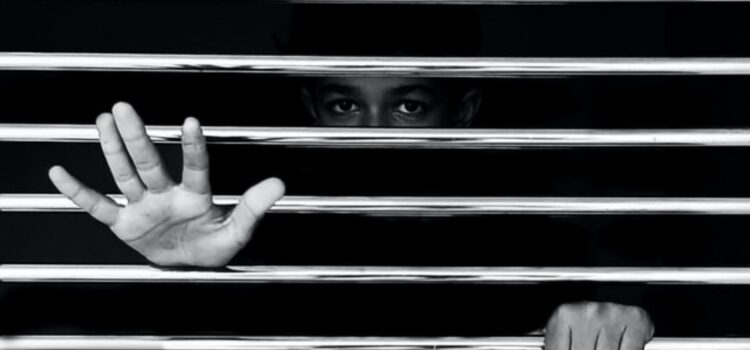

This article is an excerpt from the Shortform book guide to "Just Mercy" by Bryan Stevenson. Shortform has the world's best summaries and analyses of books you should be reading.
Like this article? Sign up for a free trial here.
Why are there so many incarcerated veterans with PTSD in the U.S.? What happened to veteran Herbert Richardson when he was in prison?
The U.S. Justice System fails to recognize veterans who are dealing with trauma and have difficulty readjusting to life after war. Just Mercy by Bryan Stevenson uses the example of Herbert Richardson to show how PTSD is disregarded in trials.
Keep reading to learn more about the unfair treatment of incarcerated veterans with PTSD.
Extreme Punishments of Veterans
Stevenson argues that the U.S. Justice System disproportionately imprisons traumatized veterans, who can’t smoothly return to society after their service has scarred them.
For example, Stevenson notes that 20% of the incarcerated population in the 1980s had served time in the military. This disproportionate rate, he suggests, was the result of the Vietnam War: Soldiers that brought home war trauma were most likely to end up incarcerated. Consequently, though Stevenson concedes that the rate dropped in the ‘90s, he notes it has started to increase as a result of war in Afghanistan and Iraq.
(Shortform note: Thus far, Stevenson’s suggestion that the rate of incarcerated veterans with PTSD could start to increase hasn’t panned out: In 2012, veterans accounted for 6.2% of the U.S.’s prison population, whereas in 2018 that rate dropped slightly to 6.0%, followed by a low of 5.6% in 2021. So, it seems the percentage of incarcerated veterans has actually dropped in the most recent decade. Experts credit this decrease in part to services such as “veterans courts,” which offer veterans psychological treatment instead of jail time for some offenses.)
To demonstrate the system’s failure toward veterans, Stevenson recounts the story of Herbert Richardson, a traumatized Vietnam War veteran. Suffering from severe post-traumatic stress disorder (PTSD), Richardson began dating a nurse in Alabama and grew obsessed with her. However, she recognized his obsession and tried to sever the relationship.
Richardson’s reasoning, Stevenson writes, became faulty and deluded. Consequently, he built a small bomb to detonate on his ex-girlfriend’s porch, planning to win her affection by rescuing her after the explosion. However, his ex-girlfriend’s niece found the bomb first and decided to shake it; she was killed instantly by the explosion.
| How Trauma Harms Veterans’ Ability to Form Relationships In The Body Keeps the Score, Bessel van der Kolk explores the lasting effects of trauma on survivors’ bodies and brains. With respect to veterans in particular, he argues that they constantly replay traumatizing wartime episodes—such as bomb detonations, gunfire, and friends’ deaths—which perpetuates the cycle of trauma. Because these flashbacks can occur at any time, van der Kolk notes that they can be more harmful than the original event, which at least had a definitive end. To avoid these painful flashbacks, veterans often fixate on some distraction, whether it’s the gym, drugs, or—in Richardson’s case—a romantic partner. However, because traumatized veterans have experienced severe harm from other humans, their capacity for trust and intimate connection is hindered. Consequently, veterans can experience deep-seated feelings of isolation, leading them to act dangerously; in Richardson’s case, this trauma-induced isolation may have fueled his obsession with his ex-girlfriend. Additionally, experts argue that veterans are often hesitant to seek treatment for PTSD because of stigma against mental illness that’s especially prevalent in the military. Nonetheless, others note that cognitive behavioral therapy (CBT) has proven effective in treating PTSD among combat veterans, and the US Department of Veterans Affairs (VA) provides an array of treatment options for traumatized veterans. |
At trial, the prosecution argued that Richardson was evil, rather than recognizing that trauma had made him mentally unstable. Further, Stevenson mentions that the prosecution claimed Richardson had intended to kill, making the crime punishable with the death penalty.
Meanwhile, because Alabama law only paid public defenders $1,000 for preparation time, Richardson’s counsel—who was later disbarred—didn’t research any mitigating factors, like his military tenure and lasting trauma. So, after a one-day trial, the judge sentenced Richardson to death. Despite Stevenson’s best efforts to get a stay of execution, the sentence was carried out: Richardson was executed via electric chair in August of 1989. As he walked to his death, the prison played the hymn, “The Old Rugged Cross,” per his final request.
(Shortform note: Although executions via electric chair have become less common, with some state supreme courts deeming it cruel and unusual punishment, it remains an option for prisoners to request in eight states. Indeed, Governor Henry McMaster even made the electric chair the default method in South Carolina in 2021, though a South Carolina judge ruled it unconstitutional in 2022.)

———End of Preview———
Like what you just read? Read the rest of the world's best book summary and analysis of Bryan Stevenson's "Just Mercy" at Shortform.
Here's what you'll find in our full Just Mercy summary:
- An examination of the justice system's failures toward marginalized populations
- Examples of criminal cases from history that illistrate the failures
- Possible solutions for repairing the justice system in America






